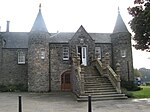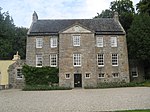Inverury and Old Meldrum Junction Railway
1855 establishments in ScotlandClosed railway lines in ScotlandEarly Scottish railway companiesGreat North of Scotland RailwayPages with no open date in Infobox station ... and 4 more
Railway companies disestablished in 1866Railway companies established in 1855Railway lines opened in 1856Standard gauge railways in Scotland
The Inverury and Old Meldrum Junction Railway was a railway company in Aberdeenshire, Scotland, that opened a short branch line between the places in its name. (The spelling has been changed over the years.) It was built by local people to revive the fortunes of a market town that had declined, and it opened in 1856. The railway was a commercial failure, and it was soon leased to the larger Great North of Scotland Railway (GNoSR), and it was absorbed by the GNoSR in 1866. Road vehicle competition worsened the railway's already weak position and in 1931 the passenger service was discontinued. In 1966 the branch line was completely closed down.
Excerpt from the Wikipedia article Inverury and Old Meldrum Junction Railway (License: CC BY-SA 3.0, Authors).Inverury and Old Meldrum Junction Railway
Westend Gardens,
Geographical coordinates (GPS) Address Nearby Places Show on map
Geographical coordinates (GPS)
| Latitude | Longitude |
|---|---|
| N 57.334 ° | E -2.328 ° |
Address
Old Meldrum
Westend Gardens
AB51 0JG
Scotland, United Kingdom
Open on Google Maps







